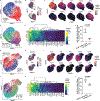T Cells Instruct Immune Checkpoint Inhibitor Therapy Resistance in Tumors Responsive to IL1 and TNFα Inflammation
- PMID: 39404741
- PMCID: PMC11790381
- DOI: 10.1158/2326-6066.CIR-24-0416
T Cells Instruct Immune Checkpoint Inhibitor Therapy Resistance in Tumors Responsive to IL1 and TNFα Inflammation
Abstract
Resistance to immune checkpoint inhibitors (ICI) is common, even in tumors with T-cell infiltration. We thus investigated consequences of ICI-induced T-cell infiltration in the microenvironment of resistant tumors. T cells and neutrophil numbers increased in ICI-resistant tumors following treatment, in contrast to ICI-responsive tumors. Resistant tumors were distinguished by high expression of IL1 receptor 1, enabling a synergistic response to IL1 and TNFα to induce G-CSF, CXCL1, and CXCL2 via NF-κB signaling, supporting immunosuppressive neutrophil accumulation in tumor. Perturbation of this inflammatory resistance circuit sensitized tumors to ICIs. Paradoxically, T cells drove this resistance circuit via TNFα both in vitro and in vivo. Evidence of this inflammatory resistance circuit and its impact also translated to human cancers. These data support a mechanism of ICI resistance, wherein treatment-induced T-cell activity can drive resistance in tumors responsive to IL1 and TNFα, with important therapeutic implications.
©2024 American Association for Cancer Research.
Figures






References
-
- Le DT, Uram JN, Wang H, Bartlett BR, Kemberling H, Eyring AD, et al. PD-1 Blockade in Tumors with Mismatch-Repair Deficiency. New England Journal of Medicine [Internet]. 2015;372:2509–20. Available from: http://www.nejm.org/doi/10.1056/NEJMoa1500596 - DOI - PMC - PubMed
-
- Petrelli F, Ghidini M, Ghidini A, Tomasello G. Outcomes Following Immune Checkpoint Inhibitor Treatment of Patients With Microsatellite Instability-High Cancers: A Systematic Review and Meta- analysis. JAMA Oncol [Internet]. American Medical Association; 2020. [cited 2022 Mar 31];6:1068–71. Available from: https://jamanetwork.com/journals/jamaoncology/fullarticle/2765752 - PMC - PubMed
-
- Li F, Li C, Cai X, Xie Z, Zhou L, Cheng B, et al. The association between CD8+ tumor-infiltrating lymphocytes and the clinical outcome of cancer immunotherapy: A systematic review and meta-analysis. EClinicalMedicine [Internet]. Elsevier Ltd; 2021. [cited 2022 Jun 26];41:101134. Available from: http://www.thelancet.com/article/S2589537021004144/fulltext - PMC - PubMed
MeSH terms
Substances
Grants and funding
- T32 AI007334/AI/NIAID NIH HHS/United States
- 1P50CA168504/National Cancer Institute (NCI)
- R01 DE032033/DE/NIDCR NIH HHS/United States
- ImmunoX Computational Biology Initiative/University of California, San Francisco (UCSF)
- P50 CA168504/CA/NCI NIH HHS/United States
- Parker Fellow/Parker Institute for Cancer Immunotherapy (PICI)
- T32GM1365471/National Institute of General Medical Sciences (NIGMS)
- 20-20-01-SPIT/American Association for Cancer Research (AACR)
- BC220499/U.S. Army Medical Research Acquisition Activity (USAMRAA)
- Stanford Propel Postdoctoral Scholarship/Stanford University (SU)
- T32 GM136547/GM/NIGMS NIH HHS/United States
- DP5 OD023056/CD/ODCDC CDC HHS/United States
- T32 5T32AI007334-33/National Institute of Allergy and Infectious Diseases (NIAID)
- F31 CA265128/CA/NCI NIH HHS/United States
- GRFP fellowship/National Science Foundation Graduate Research Fellowship Program (GRFP)
- DP5 OD023056/OD/NIH HHS/United States
- Clinician Scientist Development Grant ASTRO-CSDG-23-1036400-01-IBCD/American Cancer Society (ACS)
- F31 CA271748/CA/NCI NIH HHS/United States
- S10 OD018040/CD/ODCDC CDC HHS/United States
- S10 OD018040/OD/NIH HHS/United States
- CRI4437/Cancer Research Institute (CRI)
- RSG-22-141-01-IBCD/American Cancer Society (ACS)
- F31CA271748/National Cancer Institute (NCI)
- UCSF Prostate Cancer Program Pilot/University of California, San Francisco (UCSF)
- Investigator support/Chan Zuckerberg Biohub
LinkOut - more resources
Full Text Sources
Medical

